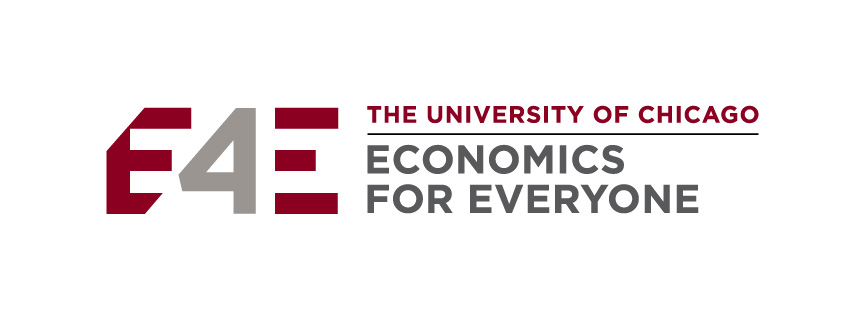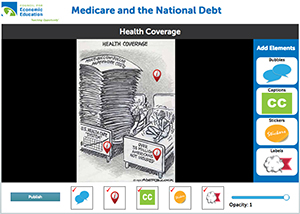
Grades 9-12

Don't have an account yet? Sign up for free
Don't have an account yet? Sign up for free


Don’t ever argue with me [about health]. I’ll go a hundred million or billion on health or education. I don’t argue about that any more than I argue about Lady Bird [Mrs. Johnson] buying flour. You got to have flour and coffee in your house. Education and health. I’ll spend the goddamn money. I may cut back some tanks. But not on health.
—Lyndon B. Johnson, 1965 (New York Times, 2009)
Essential Dilemma – Can we guarantee quality health care to the elderly in a way that is both efficient and equitable?
In this lesson, students will re-ask the question President Johnson answered for himself over 50 years ago: How high a value do we place on guaranteeing quality health care to the elderly? This lesson is about Medicare, the country’s health insurance program for people age 65 or older, and the level of quality of the care we wish to maintain for the elderly. That question cannot, however, be understood without looking more broadly at quality and cost of U.S. health care. Health care in the United States is not nearly the most effective in the world, but it is by far the most expensive. In 2015, the United States ranked 43rd out of 224 nations in the world in life expectancy, with an average of 79.68 years (Central Intelligence Agency [CIA], 2015b). The United States also has the 58th best infant mortality rate in the world, with 5.87 infant mortalities for every 1,000 live births (CIA, 2015a).
Yet in 2013, the United States spent about 16.4% of its gross domestic product (GDP; a measure of total yearly output of the economy) on health care, nearly double the average of 8.8% among other developed countries. Average healthcare spending per person in the United States was $8,713 in 2013, compared to an average of $2,112 per person in 1970, adjusted for inflation (Organisation for Economic Co-operation and Development [OECD], 2016).
In light of these high costs, middling outcomes, and limited access to health insurance coverage, on March 23, 2010, President Barack Obama signed the Patient Protection and Affordable Care Act (ACA). The ACA, colloquially known as “Obamacare,” is an expansive law that aimed to expand insurance coverage through various private and public mechanisms, increase the quality of health coverage and care, and contain costs. There is some evidence that the law is succeeding in achieving some of its stated objectives; as of 2015, the percentage of Americans without health insurance had declined to 13.2% (compared to 15.7% in 2005), and over 14 million people had gained coverage through various provisions of the law (U.S. Department of Health and Human Services, 2005, 2015).
Although this lesson focuses on Medicare, one specific government-sponsored health insurance program for the elderly and other specific populations, the passage and provisions of the ACA provide important context for understanding issues of efficiency and equity in the provision of health care, as well as for understanding complex debates about the role of government in health care. Finally, historical trends in costs and access should be interpreted in light of this legislation.
Although President Johnson was clear on his priorities in providing services he perceived as vital, regardless of high and rapidly increasing costs, such costs cannot be ignored entirely. Few would be in favor of lower-quality health care for more money, of course, so many are in agreement that some reform is necessary. An economic analysis of Medicare can help in thinking about reform. Economic arguments about the ideal way to provide for the nation’s health care center on questions of equity (which can be broadly thought of as fairness), efficiency (using resources to achieve maximum production), costs, benefits, and trade-offs. These principles of equity, efficiency, costs, benefits, and trade-offs are the foundation for many of the positions public policymakers take on how to provide health care. Proponents of an increased role for the government (also called the public sector) argue that the current system is inequitable, and that health care is a right, not a privilege or commodity. Opponents to a larger role for government, including politically conservative policymakers, corporations that do not want to be regulated, and economic libertarians, argue that moving towards a larger role for the public sector would limit economic freedom of choice for consumers, whereas moving in the other direction and providing a larger role for the private sector would expand that choice.
Many opponents to the current role the government plays in providing health care to the elderly cite the cost. They argue that the trade-offs are unacceptably high and that among those trade-offs is a more balanced federal budget. Many on all sides of the debate would argue that the current public–private hybrid system is inefficient, producing mediocre results at enormous cost. There is wide disagreement on the solution to this problem, however.
| Those opposed to an increased role for government argue that the government-subsidized system produces perverse incentives to provide excessive services rather than necessary care, and a fully private system would produce efficiency through the profit motive. | Those in favor of an increased role for government argue that the hybrid system should be replaced by a government-run system with lower administrative costs and less money being absorbed as profits for insurance companies and healthcare providers. |
These issues are complex. They raise deep and important questions about the government’s role in the economy and how goods and services should be produced, especially when those goods and services are viewed as vital to the population. This lesson does not attempt to provide answers to these challenging questions as they apply to health care or impact Medicare. Instead, the lesson raises three key questions for students to ponder:
UNDERSTAND
BE ABLE TO
Day 1 of 2
ENTRY
Should We Be Worried?
Distribute “Health Coverage” (Resource 1), a cartoon illustrating some of the challenges of healthcare reform. Inform students that the cartoon was drawn by legendary cartoonist Herb Block in 1991. Give students about 5 minutes to independently examine the cartoon, writing down what they notice in the images and text, what inferences they can make, and what questions they have. Invite students to share their thoughts about the cartoon. If the following points do not emerge, prompt them with further questioning:
 Online Extension: Students may use CEE’s Image Annotation Tool to comment upon the cartoon. Encourage students to add a caption, thought and/or speech bubbles, and clip art stickers to reinforce the meaning of the cartoon. As an added challenge, have students use these tools to alter the meaning of the cartoon, presenting a perspective that differs from that of the cartoonist.
Online Extension: Students may use CEE’s Image Annotation Tool to comment upon the cartoon. Encourage students to add a caption, thought and/or speech bubbles, and clip art stickers to reinforce the meaning of the cartoon. As an added challenge, have students use these tools to alter the meaning of the cartoon, presenting a perspective that differs from that of the cartoonist.
Inform students that:
This lesson will help students use economic concepts to analyze the current and future costs and benefits of government-run health care, with a particular focus on Medicare. Students will use the economic concepts of equity, efficiency, costs, benefits, and trade-offs to frame questions and weigh evidence on the current state of the healthcare system, its projected future, and proposed reforms.
LESSON STRATEGIES AND ACTIVITIES
Background and Context
Distribute “Health Care and the Uninsured” (Resource 2). Ask students to “read” the cartoon and series of graphs and then, either individually or working with one other student, write a short paragraph that tells the same story in words. Tell them they are to identify the key problems with, and barriers to, healthcare coverage. Review these graphs and the cartoon as a class and tell students they will be coming back to them when they identify criteria for reforming the healthcare system.
Distribute “Overview of Medicare,” which is included with this packet (and available online). If students are unfamiliar with the specific provisions of Medicare, ask them to read the program description carefully and answer the following questions.
The Costs and Benefits of Medicare
The federal government [is] . . . a giant insurance company, mainly serving older people, that also has an army.
—Paul Krugman (2011)
In this section, students will examine data to explore the costs and benefits of Medicare. Although the previous discussion focused on healthcare policy more generally, the next two segments of the lesson will focus on Medicare as a specific example. The charts and graphs found in “Costs and Benefits: Visualizations” (Resource 3) will provide students with additional context on this specific program, which can help inform their judgment about healthcare policy more generally.
Distribute the charts and cartoon and ask students to work in groups to note observations, inferences, and questions they have about the costs and benefits of Medicare. Circulate among the groups of students and probe their observations of the data. Prompt them with further questioning to engage them in looking at data from multiple sources: What information can they gather from the charts? What types of information do the charts use? What is the source of this information, and do the students find the source credible? What additional information would be necessary to put this information in context and draw conclusions about the costs and benefits of Medicare? Lead a class discussion on the findings, pushing students to dig deeper into the evidence.
If these points do not emerge, ask students:
Tell students that, in a May 12, 2011, column in the New York Times, economist Paul Krugman described the federal budget, writing, “. . . here’s the quick-and-dirty summary of what the federal government does: It’s a giant insurance company, mainly serving older people, that also has an army.” In the same column he wrote, “By my rough count, in 2007, seniors accounted, one way or another, for about half of federal spending” (Krugman, 2011).
Ask students to comment on what that seems to say about our priorities as a nation.
[Student answers will vary, but some may notice that the amount of spending on seniors has grown due to the increases in the costs of health care, and may not represent current priorities.]
Optional Homework
For homework, consider asking students to read “How the Performance of the U.S. Healthcare System Compares Internationally” (Resource 4) and then interpret this quote from the Congressional Budget Office:
In itself, higher spending on health care is not necessarily a “problem.” Indeed, there might be less concern about increasing costs if they yielded commensurate gains in health. But the degree to which the system promotes the population’s health remains unclear. Indeed, substantial evidence exists that more expensive care does not always mean higher-quality care. Consequently, embedded in the country’s fiscal challenge is the opportunity to reduce costs without impairing health outcomes overall.
—Congressional Budget Office (2007)
How does this quote relate to what they have learned so far? Does the evidence they have seen support this conclusion? What additional evidence would they like to see to test it?
[Student responses may relate the quote to the opening cartoon, statistics about healthcare coverage, and/or charts and data about healthcare spending. Some students may agree with the quote, citing evidence in Resource 4 that (1) healthcare costs are rising and are already the highest in the world, and (2) healthcare outcomes in this country are mediocre. Other students might highlight the benefits of programs like Medicare, citing evidence in Resources 2 and 4, and the potential harm that could come from across-the-board cuts, even if the money is not being spent efficiently. Students with outside knowledge might mention the range of pharmaceutical and technological innovations developed through research funded by the very expensive U.S. healthcare system, and argue that these benefit people around the world. Student questions and evidence will vary, but they might wish to collect more data that compare the U.S. healthcare system to that of other countries, analyze healthcare changes over time, or compare costs and outcomes across states or regions, to test this hypothesis.]
Day 2 of 2
On the Horizon: The Sustainability of Medicare
Begin by reviewing with students the current costs and benefits of Medicare. Ask students what they might expect to happen if previous trends continue into the future.
[Student responses may include that healthcare spending, as a percentage of GDP, has been increasing and may continue to rise in the future. Although life expectancy has been improving, other outcomes have not kept pace with other countries that spend much less on health care.]
Inform students that, given concerns about recent trends and the high cost of health care in the United States, several plans to reform the healthcare system have been proposed over the past few decades, including the Patient Protection and Affordable Care Act of 2010. These plans aim to (1) reduce costs; (2) improve care, though potentially reducing benefits to some; (3) make health care more efficient; (4) provide health care to more people; and (5) possibly change the way health care is provided.
In order to evaluate any of these plans, students will need to see how the costs and benefits of healthcare programs are projected to change in the future. Once again, students will look at Medicare as one specific example, but that example can be useful in thinking about healthcare policy more generally.
Distribute “Projecting Future Costs and Benefits of Medicare” (Resource 5), which includes projections on changes to healthcare spending and the population receiving Medicare. Students should examine the resources in groups, with a similar set of questions to those used to analyze Resource 4. After students have examined the resources for about 10 minutes, discuss what the projections show. Prompt students with the following if these points do not emerge:
Emphasize to students that these issues are complex, and part of the purpose of this lesson is to reveal the complexity of the issue and the reasons it has been so difficult to resolve, both practically and politically. In particular, data on the persistently high portion of personal income the elderly spend on health care reveal that programs can have unintended consequences, but they still may be worth the costs. Students should be encouraged to notice patterns and raise questions, but reminded that patterns and correlations do not necessarily imply causation, and further research would be necessary to draw any solid conclusions based on this information.
Establishing Criteria for Evaluating Healthcare Reform Proposals
Use the discussion of the last question to transition to the closure for this lesson. Remind students that, although this lesson focuses on Medicare, they should also consider the implications for health care more generally. Ask students to recap everything they have learned about healthcare policy and the Medicare program, including how it works, and costs and benefits in the present and future.
Using this information, as well as their own values and priorities, students will envision themselves as economics experts who write editorials and appear on television news broadcasts offering commentary and analysis on the news of the day. They will need to be equipped to judge any proposed healthcare reform using a consistent set of criteria, rooted in economic theory. Students will therefore use the graphic organizer in Resource 6 to create a set of four or five criteria around economic concepts, including equity, efficiency, costs, benefits, and trade-offs. They do not need to use these particular criteria; they can create their own, combine these concepts into larger criteria, or create new names and headings. Within each criterion, students then need to create a set of questions they would ask and decide what evidence they would want to determine if the proposal met the criteria.
If students struggle with envisioning how they would judge any given criterion, share concrete examples of healthcare reforms that have been proposed in the past. Several are available online, including pages 36–43 of “The Moment of Truth: Report of the National Commission on Fiscal Responsibility and Reform” at https://web.archive.org/web/20170120051225/https://www.fiscalcommission.gov/ .
Kaiser Health has also assembled a list of opinion columns from various newspapers around the country that offer suggestions for reforming Medicare and other healthcare reform issues. The list is at https://www.kff.org/perspectives/ . (Select the checkbox marked “Medicare” to filter for links focused on that program.)
Close by having groups of students share criteria with one another, keeping the essential dilemma of the lesson in mind as they listen to each proposal. For homework, each student should write a brief essay (1) using the criteria they have identified as important to respond to the essential dilemma, and (2) using the range of criteria among their classmates to explore why there is or is not consensus on the issue.
ADDITIONAL STANDARDS
Common Core State Standards (CCSS) Initiative
CCSS.ELA-Literacy.RI.11-12.6. Determine an author’s point of view or purpose in a text in which the rhetoric is particularly effective, analyzing how style and content contribute to the power, persuasiveness or beauty of the text.
CCSS.ELA-Literacy.RI.11-12.7. Integrate and evaluate multiple sources of information presented in different media or formats (e.g., visually, quantitatively) as well as in words in order to address a question or solve a problem.
CCSS.ELA-Literacy.RH.9-10.7. Integrate quantitative or technical analysis (e.g., charts, research data) with qualitative analysis in print or digital text.
The College, Career, and Civic Life (C3) Framework for Social Studies State Standards
D2.Eco.6.9-12. Generate possible explanations for a government role in markets when market inefficiencies exist.
D2.Eco.7.9-12. Use benefits and costs to evaluate the effectiveness of government policies to improve market outcomes.
REFERENCES CITED
Barry-Jester, A. M., & Casselman, B. (2015, September 28). 33 million Americans still don’t have health insurance. FiveThirtyEight. Retrieved from https://fivethirtyeight.com/features/33-million-americans-still-dont-have-health-insurance/
Block, H. (1991, May 3). Health coverage. The Herb Block Foundation. Retrieved from https://www.loc.gov/item/00652270/
Center on Budget and Policy Priorities. (2016, March 4). Policy basics: Where do our federal tax dollars go?, p. 2. Retrieved from https://www.cbpp.org/sites/default/files/atoms/files/4-14-08tax.pdf
Central Intelligence Agency. (2015a). Country comparison: Infant mortality rate. CIA World Factbook. Retrieved from https://www.cia.gov/the-world-factbook/
Central Intelligence Agency. (2015b). Country comparison: Life expectancy at birth. CIA World Factbook. Retrieved from https://www.cia.gov/the-world-factbook/
Congressional Budget Office. (2007). The long-term outlook for health care spending, pp. 7, 13. Retrieved from https://www.cbo.gov/sites/default/files/109th-congress-2005-2006/reports/01-26-budgetoutlook.pdf
Davis, K., Stremikis, K., Schoen, C., & Squires, D. (2014, June). Mirror, mirror on the wall, 2014 update: How the U.S. health care system compares internationally. The Commonwealth Fund. Retrieved from https://www.commonwealthfund.org/publications/fund-reports/2014/jun/mirror-mirror-wall-2014-update-how-us-health-care-system
DeNavas-Walt, C., & Proctor, B. D. (2015). Income and poverty in the United States: 2014, p. 22. Retrieved from https://www.census.gov/content/dam/Census/library/publications/2015/demo/p60-252.pdf
Henry J. Kaiser Family Foundation. (2015, October). Key facts about the uninsured population. Retrieved from http://files.kff.org/attachment/fact-sheet-key-facts-about-the-uninsured-population
Krugman, P. (2011, May 12). Seniors, guns and money. New York Times. Retrieved from https://www.nytimes.com/2011/05/13/opinion/13krugman.html?mtrref=undefined&gwh=441A1CBA063EC1E6F73080AF16910B82&gwt=pay
Lane, M. (2003, September 30). No health insurance. Cagle Cartoons. Retrieved from http://www.politicalcartoons.com/cartoon/bed42e24-9ae1-4ed0-9609-1a1de6bfaa08.html
Medical Payment Advisory Commission. (2015, June). A data book: Health care spending and the Medicare program, p. 4. Retrieved from http://garnerhealth.com/wp-content/uploads/2014/02/june-2015-databook-health-care-spending-and-the-medicare-program.pdf
New York Times. (2009, September 19). “Don’t let dead cats stand on your porch”: A tutorial from Lyndon B. Johnson. Retrieved from https://www.nytimes.com/2009/09/20/weekinreview/20word.html
Organisation for Economic Co-operation and Development. (2016, May). OECD health data—health expenditure and financing. Retrieved from https://stats.oecd.org/Index.aspx?DataSetCode=SHA
Sheneman, D. (2011). Medicare cuts. Tribune Media Services. Retrieved from https://www.gocomics.com/drewsheneman/2011/04/13
U.S. Department of Health and Human Services. (n.d.). Fiscal year 2017 budget in brief, p. 66. Retrieved from https://www.hhs.gov/sites/default/files/fy2017-budget-in-brief.pdf
U.S. Department of Health and Human Services. (2005). Overview of the uninsured in the United States: An analysis of the 2005 Current Population Survey. Retrieved from https://aspe.hhs.gov/basic-report/overview-uninsured-united-states-analysis-2005-current-population-survey
Extension activity not available.

Grades 9-12

Grades 9-12

Grades 9-12

Grades 9-12
